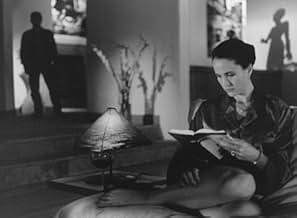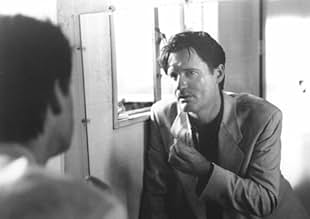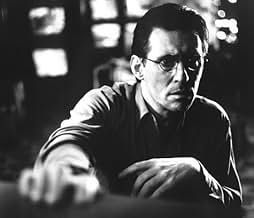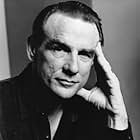IMDb RATING
5.6/10
5.4K
YOUR RATING
Mike is a successful Hollywood producer of violent movies. Then he himself experiences extreme violence, goes missing, joins some Latino gardeners and reviews his life.Mike is a successful Hollywood producer of violent movies. Then he himself experiences extreme violence, goes missing, joins some Latino gardeners and reviews his life.Mike is a successful Hollywood producer of violent movies. Then he himself experiences extreme violence, goes missing, joins some Latino gardeners and reviews his life.
- Awards
- 1 win & 4 nominations total
Nicole Ari Parker
- Ade Kenya
- (as Nicole Parker)
Samuel Fuller
- Louis Bering
- (as Sam Fuller)
Featured reviews
...or as I like to think of it, THE END OF VIOLENCE is the greatest scifi crime thriller that never was.
As always with Wim Wenders, the plot is fantastic. But, as always with Wim Wenders, the movie isn't about the plot, and those who expect to be carried by the plot will be disappointed. In the same way WINGS OF DESIRE had a great plot about angels but was not a fantasy; in the same way UNTIL THE END OF THE WORLD had a great plot about a high tech dream machine but was not about technology; in the same way LISBON STORY had a riveting plot about a missing person but was not a mystery, here we have the same Wendersian formula which he pulls off flawlessly.
The plot, if you're curious, is about a futuristic "God machine" that can eliminate people with the push of a button. Designed ostensibly for crime prevention & surveillance (the old "to protect & serve" - where have we heard that before?), it gets out of control and takes murder & corruption to the next level of clinical perfection. Caught up in the game is Mike Max, a movie producer struggling with his own intense xenophobia and paranoia, which, like a disease, he himself spreads to society through his films.
That's all I'll say about the plot because (a) I don't want to ruin anything, and (b) like I said, the plot is secondary. What's really important, as you watch this movie, is to pay attention to the thought-provoking dialogue, the philosophical allusions and the overall metaphor of the situation. If you can tune into that stuff, then you're set for a great experience.
I'll give you just one example of the philosophy. There's a scene early on where they talk about the "observer effect" (you might recognize it as the paradox of "Schrödinger's cat" which you can look up on wikipedia). This is the fundamental theme of the film: the idea that, even by "impartially observing", we change the situation or in some cases destroy it. As one of the characters says, it's like "flipping on the light to observe the darkness." What a poetic & appropriate analogy.
This movie is choc full of that kind of stuff, and you may miss it if you're expecting car chases and gunfire. No, instead you get the ultimate anti-violence violence film, and I gotta give Wenders a standing ovation on being the first director I've seen pull it off.
A lot of movies in the past have carried a message of anti-violence; yet the films sink to the thrill of showing violence themselves and often glorifying it (the biggest example would be Norm Jewison's classic ROLLERBALL), and this becomes confusing if not outright hypocritical. But in this case, we get a chilling depiction of the epidemic of violence without showing any blood & guts to excite our savage instincts. It remains an intellectual film, not visceral. Don't get me wrong; this movie is plenty suspenseful, and on more than one occasion it'll have your heart flopping like an electrified noodle. But it's all done by way of the mind. To me, that's what makes this depiction of violence all the more effective & frightening: the way it's so clean & neat like in a video game. And without any fuss, someone's head could just go pop.
This is the best film I've seen in a while. I'm only taking off a few points because I wished it was twice as long & had more monologues, like some of the older Wenders films. But I have to say this film sticks to its objective and delivers a perfect product.
As always with Wim Wenders, the plot is fantastic. But, as always with Wim Wenders, the movie isn't about the plot, and those who expect to be carried by the plot will be disappointed. In the same way WINGS OF DESIRE had a great plot about angels but was not a fantasy; in the same way UNTIL THE END OF THE WORLD had a great plot about a high tech dream machine but was not about technology; in the same way LISBON STORY had a riveting plot about a missing person but was not a mystery, here we have the same Wendersian formula which he pulls off flawlessly.
The plot, if you're curious, is about a futuristic "God machine" that can eliminate people with the push of a button. Designed ostensibly for crime prevention & surveillance (the old "to protect & serve" - where have we heard that before?), it gets out of control and takes murder & corruption to the next level of clinical perfection. Caught up in the game is Mike Max, a movie producer struggling with his own intense xenophobia and paranoia, which, like a disease, he himself spreads to society through his films.
That's all I'll say about the plot because (a) I don't want to ruin anything, and (b) like I said, the plot is secondary. What's really important, as you watch this movie, is to pay attention to the thought-provoking dialogue, the philosophical allusions and the overall metaphor of the situation. If you can tune into that stuff, then you're set for a great experience.
I'll give you just one example of the philosophy. There's a scene early on where they talk about the "observer effect" (you might recognize it as the paradox of "Schrödinger's cat" which you can look up on wikipedia). This is the fundamental theme of the film: the idea that, even by "impartially observing", we change the situation or in some cases destroy it. As one of the characters says, it's like "flipping on the light to observe the darkness." What a poetic & appropriate analogy.
This movie is choc full of that kind of stuff, and you may miss it if you're expecting car chases and gunfire. No, instead you get the ultimate anti-violence violence film, and I gotta give Wenders a standing ovation on being the first director I've seen pull it off.
A lot of movies in the past have carried a message of anti-violence; yet the films sink to the thrill of showing violence themselves and often glorifying it (the biggest example would be Norm Jewison's classic ROLLERBALL), and this becomes confusing if not outright hypocritical. But in this case, we get a chilling depiction of the epidemic of violence without showing any blood & guts to excite our savage instincts. It remains an intellectual film, not visceral. Don't get me wrong; this movie is plenty suspenseful, and on more than one occasion it'll have your heart flopping like an electrified noodle. But it's all done by way of the mind. To me, that's what makes this depiction of violence all the more effective & frightening: the way it's so clean & neat like in a video game. And without any fuss, someone's head could just go pop.
This is the best film I've seen in a while. I'm only taking off a few points because I wished it was twice as long & had more monologues, like some of the older Wenders films. But I have to say this film sticks to its objective and delivers a perfect product.
I'm not surprised that a child would not understand this movie. To me it was very meaningful, but only in terms of lived experience in jobs and politics. It's really "Brave New World," where authority figures keep order by putting up cameras everywhere and intervening to eliminate anyone who is disorderly or criminal. Violence is a huge preoccupation, but only tolerated as make-believe -- but the make-believe gets confused with real violence. Control, transgression, power are the pivots of the well-to-do. Ashcroft stuff.
But the Mexican and immigrant families offer a warmer, truer alternative. In the end, they are more powerful because they are free and can think. The Kinko's episode, in which the police are defeated from taking control by their own preconceptions, is a good example. As underlings, laborers, the Mexicans understand what's at stake and they are everywhere, invisible to their employers.
The intellectual technician doesn't catch on until it's too late.
I'm told that what I saw was a re-cut and that the early version was indeed chaotic with a lot of loose ends. All I can say is that now this is one of the videos I rewatch and ponder.
But the Mexican and immigrant families offer a warmer, truer alternative. In the end, they are more powerful because they are free and can think. The Kinko's episode, in which the police are defeated from taking control by their own preconceptions, is a good example. As underlings, laborers, the Mexicans understand what's at stake and they are everywhere, invisible to their employers.
The intellectual technician doesn't catch on until it's too late.
I'm told that what I saw was a re-cut and that the early version was indeed chaotic with a lot of loose ends. All I can say is that now this is one of the videos I rewatch and ponder.
A film producer who escapes death by murder and chooses to lead a simple life afterwards, a group of good Mexican gardeners, a second-rate movie actress who becomes jobless, a police officer who is not happy with the filing of his case, a Salvadoran maid whose family has been shot by death squads, a NASA employee who knows too much and his old father who doesn't want to exchange his old typewriter by a computer, a mysterious project of ending up violence in the world by putting everyone under surveillance, with all those ingredients what could a movie director have made? Surely an excellent movie. This one however is too much ambitious and produces rather poor results in comparison with that ambition. Where the contrast between dream and reality, love and greed, poetry and vulgarity could have been explored we are left with a story not bad in itself but not very deep and not especially moving.
I watched this movie a few times, and I have met very few people who liked it as much as I did. I see it as an artful expression of all the critical thoughts in philosophy, sociology etc. that show how genocide, ultra-violence and fascist methods of population-control can develop out of all the promises of order, justice and peace the the modern state makes to its citizens. Also, the dialogue has absolutely superb moments, as when Mike the fugitive of the state says to his wife confronts his ex-wife with the words "Who can I turn myself into? Well I see who you turned yourself into...". A lot of people seem to dislike the loose ends and unexplained shifts that the characters make - but I say, in that very absence of rigid structure the film makes a parallel to the manifest ambivalence of modern life as a citizen: Our greatest protector is also our greatest threat.
You don't turn to Wim Wenders when you're looking for nerve-tightening suspense. Though written (by Nicholas Klein, with Wenders) in paranoid-thriller form, the script lacks even a nubbin of McGuffin to anchor the narrative. Two stories run in parallel: Bill Pullman's an action-film producer gone missing after an attempt on his life; Gabriel Byrne's a NASA computer jock on loan to a mysterious satellite surveillance project. Just as yuppie cop Loren Dean is on the point of tying the two tales together, the movie's over, the plot unresolved.
Oh, well: Los Angeles (mainly Malibu, Santa Monica, and Griffith Park) looks great (cinematography Peter Przgoda), and Wenders has an uncanny ability to get actors to feel comfortable in their skins. The most notable skin in question is Traci Lind's: her role as a stunt-woman turned aspiring actress would have made her a star in a more mainstream movie.
If you're a Wenders fan, don't let the commercial failure of this film put you off: Compared to, say, 'Far Away, So Close' it's as electrifying as 'The 39 Steps.' And somehow, as usual, Wenders's almost childlike intensity of gaze makes you look harder, too. The aroma of the film lingers, even as its substance slides through your fingers like sand.
Oh, well: Los Angeles (mainly Malibu, Santa Monica, and Griffith Park) looks great (cinematography Peter Przgoda), and Wenders has an uncanny ability to get actors to feel comfortable in their skins. The most notable skin in question is Traci Lind's: her role as a stunt-woman turned aspiring actress would have made her a star in a more mainstream movie.
If you're a Wenders fan, don't let the commercial failure of this film put you off: Compared to, say, 'Far Away, So Close' it's as electrifying as 'The 39 Steps.' And somehow, as usual, Wenders's almost childlike intensity of gaze makes you look harder, too. The aroma of the film lingers, even as its substance slides through your fingers like sand.
Storyline
Did you know
- TriviaThere is a scene in the film where we see a live recreation of the painting "Nighthawks" by Edward Hopper.
- GoofsWhen Page is holding Mike at gunpoint she holds the gun upward with the bottom of the handle facing outward and the ammo clip is clearly missing. Yet when Mike exits through the patio door she fires the gun and shatters the glass.
Obviously there was a bullet in the chamber.
- SoundtracksBailare (El Merecumbe)
Written, Performed and Produced by Raul Malo
Courtesy of MCA Records, by arrangement with Universal Music
Special Markets
- How long is The End of Violence?Powered by Alexa
Details
- Release date
- Countries of origin
- Languages
- Also known as
- El final de la violència
- Filming locations
- Griffith Observatory, 2800 E Observatory Rd, Los Angeles, California, USA(Multiple interior and exterior scenes; as Ray Bering's workshop. Hillside hike viewpoint just south of observarory)
- Production companies
- See more company credits at IMDbPro
Box office
- Budget
- $5,000,000 (estimated)
- Gross US & Canada
- $386,673
- Gross worldwide
- $386,673
- Runtime2 hours 2 minutes
- Color
- Sound mix
- Aspect ratio
- 2.35 : 1
Contribute to this page
Suggest an edit or add missing content






































